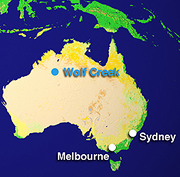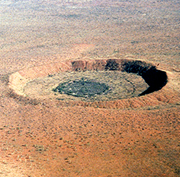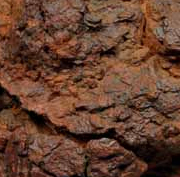Official Name:
The Wolfe Creek meteorite gets its name from a creek that passes near the site of impact.
Location:
Located 75 kilometres south of the town of Halls Creek, in the Kimberley region of Western Australia. The Wolfe Creek crater is Australia's least accessible impact structure. It is situated at the edge of the Great Sandy Desert, which is essentially unexplored.
Fall or Find:
Wolfe Creek is a find. The meteorite fell over 300 000 years ago.

Enlargement
Wolfe Creek crater is located in the northwest part of Australia. |
|

Enlargement
Aerial view of Wolfe Creek crater. It is the second largest crater to have yielded meteoritic debris. |
|
Date:
The colossal circular crater was discovered in 1947 by aviators doing an aerial survey for an oil company. Two months later, the team travelled to the site by land, and it was confirmed that the structure was meteoritic in origin.
Mass Recovered:
At least 635 kilograms of meteoritic matter was recovered during a large-scalescientific expedition in 1953-1954.
Number of Fragments:
The meteoroid was almost completely destroyed on impact. Only a few fragments survived. When they were discovered, they were either very altered or totally oxidized. The majority of the fragments are small and spherical. Three masses of about 150 each were recovered. They're a hundred times more massive that the other fragments recovered.
Crater:
Wolfe Creek crater is 875 metres in diameter and 50 metres deep. Before gradually filling with sand, the crater was three times deeper. The walls rise 35 metres above the surrounding desert plane. Rich vegetation grows in the bottom of the crater because of the rainwater that collects in this enormous bowl.
The formation of the crater altered the surrounding rock. The impact deformed the local quartzite, and enormous blocks of it were ejected around the crater. Tektites formed. The terrestrial rock that vaporized when the meteoroid struck fell back to the ground as vitreous masses.
|
|

Enlargement
A spherical-and highly oxidized-fragment of the Wolfe Creek meteorite. |
|
Circumstances:
The meteoroid was travelling from northeast to southwest. According to estimates, the object weighed 50 000 metric tons before impact and was moving at 15 kilometres per second.
History:
The Djaru Aboriginal people have known about the Wolfe Creek crater for a long time-they call it Kandimalal. Legend says that a rainbow snake crawled out of the crater, carving out the neighbouring creek as it slithered away.
Type:
Iron meteorite
Class:
Medium octahedrite (0.85 millimetre bands)
Group:
IIIAB
Composition:
The Wolfe Creek meteorite is mainly made up of iron. Its two other principal constituents are nickel and cobalt, which respectively total 8.6% and 0.4% of the meteorite's volume.
Scientific contribution:
Two minerals unknown on Earth were identified in oxidized fragments of Wolfe Creek. They are reevesite, a nickel-iron carbonate, and cassidyite, a calcium-nickel-magnesium phosphate. The two minerals are named for the scientists who discovered them.
Comments:
Wolfe Creek crater is the second largest crater associated with meteorite fragments. Today the crater is in a protected national park.
Part of the Planétarium's collection:
Yes